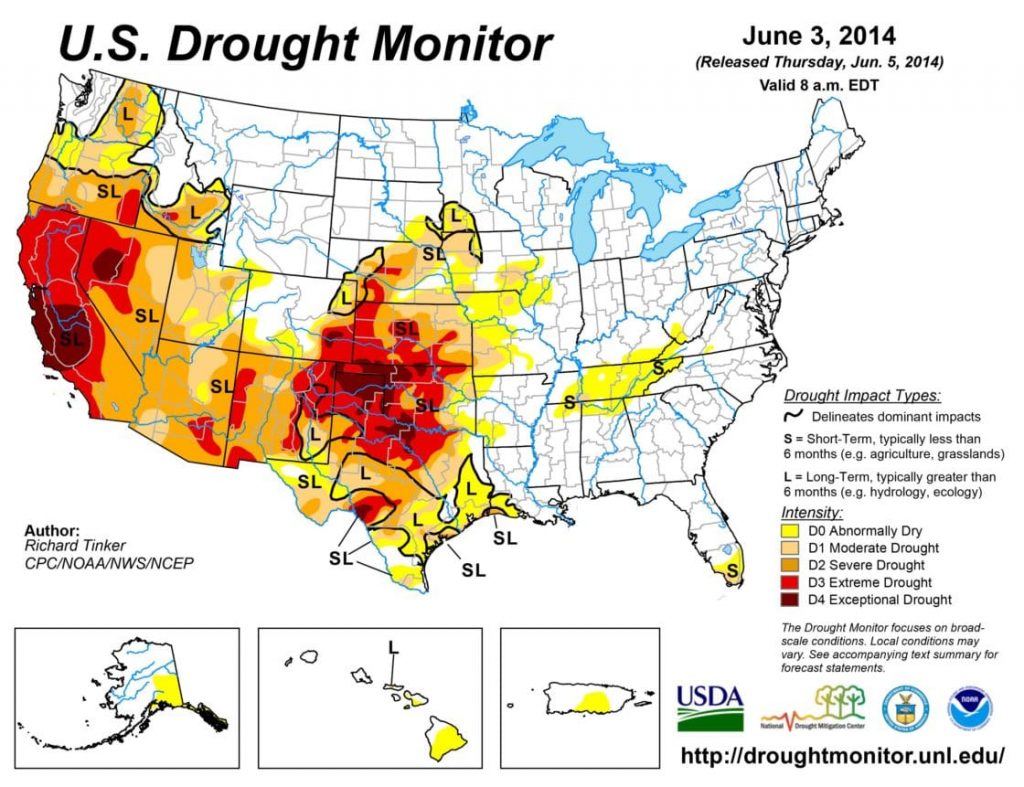Running Out Of Water
Data released by the U.S. Drought Monitor1 last month indicates that over 30% of the United States is experiencing at least moderate drought, and that seven states are actually running out of water. California, Nevada, New Mexico, Kansas, Arizona, Oklahoma, and Texas are experiencing severe drought over more than half their land area. Severe drought, or D2 on a D0-D4 scale, is designated when crop or pasture losses are likely, water shortages are common, and water restrictions are imposed. Even more alarming, six of the seven hardest hit states are experiencing extreme drought over more than 30% of their land area. Extreme drought, or D3, is designated when there are major crop/pasture losses as well as widespread water shortages or restrictions. In addition, two states are experiencing exceptional drought, which is the highest drought classification possible. Exceptional drought, or D4, is designated when there are widespread crop/pasture losses as well as water emergencies created by shortages of water in reservoirs, streams, and wells. 25% of the state of Oklahoma and 30% of the state of California have been designated D4.
The impact of severe drought is far-reaching. Drought has a major impact on crops like winter wheat, which is grown extensively in Texas, Oklahoma, and Kansas. In addition, reservoir levels are alarmingly low. Arizona’s well levels are at two-thirds of their normal level, New Mexico’s are at half, and Nevada’s are only about one-third of their usual average. In Texas, the city of Wichita Falls has made headlines recently by proposing to become the first city in the nation to draw their public drinking water directly from treated wastewater. Arizona fell victim to raging wildfires last month that are just now coming under containment. And then there’s California. The entire state is suffering from severe drought, and the majority of the state is under extreme drought. Many Californian farmers have been forced to leave their fields unseeded due to restrictions on agricultural water use. In January, Governor Jerry Brown declared a state of emergency because the state is literally running out of water. If something doesn’t change, it is estimated that California has less than two years of water remaining.
So what can we do? One of the easiest and most effective solutions is water conservation. California has a large population, and Gov. Brown has asked residents to cut their water usage by 20%. Our Earth Day blog provides a comprehensive list on water conservation around the home. In addition, farmers will need to adopt practices that lessen the effect of drought. Most importantly, we will need to rethink water. Maybe it’s time to overhaul toilets to become waterless, to broadly use treated wastewater for irrigation, or to engineer affordable, sustainable desalination methods so we can tap into our vast oceans. Whatever methods we use, one thing is certain: the nation’s water crisis needs to be an urgent priority on which we all must work together to solve. Our future depends on it.
1The U.S. Drought Monitor is produced by the U.S. Department of Agriculture (USDA), the National Oceanic Atmospheric Administration (NOAA), and the National Drought Mitigation Center at the University of Nebraska-Lincoln.

